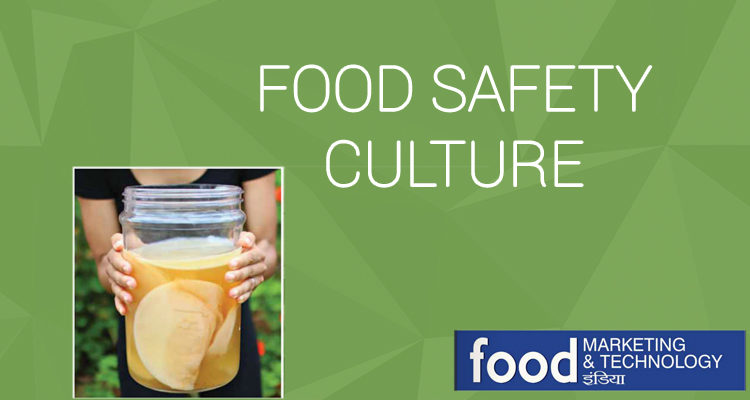Food safety has been gaining a central role in the food businesses irrespective of their nature and scale; whether be it in food processing, food service or retail. The lapse in food safety can be to detrimental to the companies to the extent of causing complete loss of business besides threatening consumer health and safety, penal actions, recovery or punitive costs, loss of long standing business, and personal reputation. Most businesses have identified this and started paying increased attention to the Food safety aspects in their overall business strategy as well as in operations. The key challenge faced by most businesses, especially in developing countries like India, is Implementing and sustaining a food safety system.
The challenge in implementing a food safety system stems from many aspects ranging from awareness, technology & design, socio-cultural, management commitment etc. The foundational aspect of implementing a food safety system at a policy or at a business level is to understand the dynamic nature of most of the food safety issues arising today. Failing to understand this and not instituting a periodical review and outlook mechanism leaves us in surprise when faced with a new kind of hazard. Most businesses fail to understand the importance of re-evaluation of their food safety systems and often the main reason attributed is that “nothing has changed at their end”. Contrary to that, much could have changed at operational level (e.g. change in employee habits) or at a supplier end (e.g. new supply chain risk, change in ingredient/ process of supplier) or at a retail level (e.g. Storage and handling at retail level).
ranging from awareness, technology & design, socio-cultural, management commitment etc. The foundational aspect of implementing a food safety system at a policy or at a business level is to understand the dynamic nature of most of the food safety issues arising today. Failing to understand this and not instituting a periodical review and outlook mechanism leaves us in surprise when faced with a new kind of hazard. Most businesses fail to understand the importance of re-evaluation of their food safety systems and often the main reason attributed is that “nothing has changed at their end”. Contrary to that, much could have changed at operational level (e.g. change in employee habits) or at a supplier end (e.g. new supply chain risk, change in ingredient/ process of supplier) or at a retail level (e.g. Storage and handling at retail level).
Management commitment is a crucial factor that determines the efficacy of the food safety system implemented. The starting step is to recognize food safety as an integral part of the business, the business owners/ management representatives taking keen interest in understanding the food safety dynamics and acknowledging that food safety risks are as serious as or more serious than other business risks. This will arm the management with enough information and understanding to allocate the necessary resources for efficient and successful implementation of a food safety system. The QA or food safety department can own and implement a food safety system, only when supported with a strong management commitment rather than having a utopian view that it has to be achieved in any other way. While it is the QA/ food safety team that implements the Food safety systems, management commitment is what shows the ultimate ownership and paves way for the effective participation of all the other stakeholders.
 Next important step is to make understand all the stakeholders that they are not external to a food safety system and their participation is as essential as the participation of QA/ food safety team. In a way, they are the owners/ implementers of the particular elements of a food safety system. Continuous training and awareness creation will be a key step in achieving unconditional participation of all the stakeholders. Rather than a cookie-cutter training, the content and delivery of the training should be such that it should help in making the stakeholders understand the relation between their roles, critical aspects of food safety interlinked and possible consequences of failing to achieve them. At times we see the whole personnel of the processing unit attending the same food safety training. The training imparted to quality and operational personnel should be different from the training directed at purchase, maintenance/ engineering, HR and Management personnel. For example, a detailed GMP (Good Manufacturing Practices) training might empower the shop floor personnel, but for HR, training on implementation and conserving the GMP practices will be far more relevant. Another important aspect in sustaining a food safety system is by combining it with the other operational systems that are relevant to each of the departments/ functions. They relevant elements of the food safety system should be made deliverables and tracked in their operational systems (e.g. marking the maintenance issues critical to food safety in preventive maintenance records, tracking non-compliant suppliers in master supplier list etc.)
Next important step is to make understand all the stakeholders that they are not external to a food safety system and their participation is as essential as the participation of QA/ food safety team. In a way, they are the owners/ implementers of the particular elements of a food safety system. Continuous training and awareness creation will be a key step in achieving unconditional participation of all the stakeholders. Rather than a cookie-cutter training, the content and delivery of the training should be such that it should help in making the stakeholders understand the relation between their roles, critical aspects of food safety interlinked and possible consequences of failing to achieve them. At times we see the whole personnel of the processing unit attending the same food safety training. The training imparted to quality and operational personnel should be different from the training directed at purchase, maintenance/ engineering, HR and Management personnel. For example, a detailed GMP (Good Manufacturing Practices) training might empower the shop floor personnel, but for HR, training on implementation and conserving the GMP practices will be far more relevant. Another important aspect in sustaining a food safety system is by combining it with the other operational systems that are relevant to each of the departments/ functions. They relevant elements of the food safety system should be made deliverables and tracked in their operational systems (e.g. marking the maintenance issues critical to food safety in preventive maintenance records, tracking non-compliant suppliers in master supplier list etc.)
Social and cultural aspects are undeniable factors that determine the success of sustaining a food safety system at operational level. Failing to consider these factors while designing will only lead to an impractical food safety plan. It is a common sight to see how the “well designed” GMP or food safety aspects are by passed at operational level. Understanding the operational conditions, environment and importantly the current behaviors and practices before designing any interventions. For example, it is impractical to wear an uncomfortable hair net throughout the day, similarly chewing Pan/ tobacco is prevalent in certain regions.Having special attention these situations is important for designing an effective intervention. At operational level, particularly in countries like India where the adoption of the harmonized food safety standards is still in nascent stage and the literacy and awareness is low among the shop floor workers, including design elements in the food safety system to make it fool proof can be an effective way to tackle social and behavioral factors. Another important aspect to uphold the food safety culture is by encouraging and rewarding the stakeholders who highlight any deviations or practices the food safety elements diligently.
Design elements can be effectively pressed to use in sustaining a food safety culture, particularly in new processing units or businesses that employs lot of manual handling of food. Some examples like hand wash stations can be interlinked with the door open control into the food processing area, extra-long foot washes etc. Most of the technology suppliers and OEMs are including the process specific controls, which are scientifically validated in the respective unit operations. In cases where the technology or process has been designed specific to the product, it is important to explore and validate any design controls applicable to prevent process failures leading to food safety issues.
Traditionally at household level we all pay high emphasis on food safety, with in the means possible. But when this comes to an enterprise level the focus on food safety is left unclear. This may be due to poor transparency among different stakeholders, lack of resources and other factors leading to failure in perceiving the big picture. A viable food safety system can only be sustained by imparting it as a culture and this is only possible when we aptly consider the foundational elements.
Author:
Source: FMT Magazine


